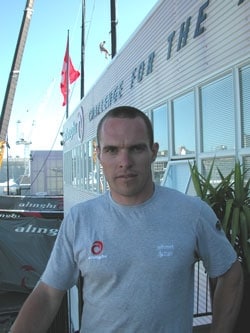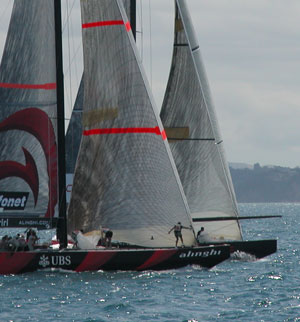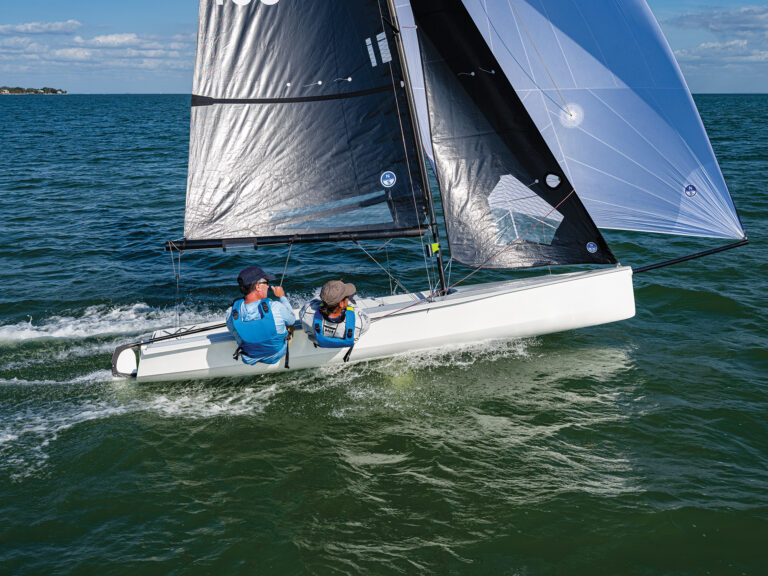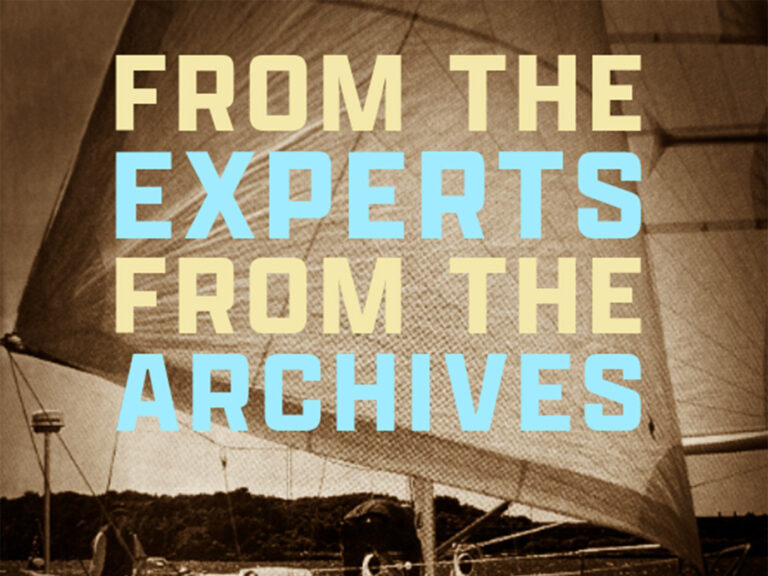
When Curtis Blewett, Alinghi’s mid-bowman, wants to know how a race is going, he’s usually got to ask one of his teammates. A major part of the 30-year-old Canadian’s job is packing the genoas and spinnakers and keeping the team’s on-board sail inventory organized, which requires him to spend a majority of the beats and some of the runs below deck. But Blewett isn’t complaining about his view, or the relative lack of exposure he’s received during this campaign while the eye of the media storm has swirled around the aft end of his boat. In fact, you’d be hard pressed to find a more contented employee. Last week, Sailing World sat down with Blewett, a veteran of the AmericaOne campaign in 2000 and the victorious EF Language campaign from the 1997-98 Whitbread Ocean Race, to get an inside look at the Alinghi campaign as it prepares to challenge for the America’s Cup.
SW: For better or worse, your individual performance is tied to the boathandling on Alinghi. How would you rate the boathandling in the last series compared to previous teams youve sailed with?
CB: The intention with any of the teams I was on, was to sail at the highest level we could at the time. In the last series against Oracle, and the sailing were doing now in-house, its the most proficient, efficient level of crew work that Ive ever sailed with. In the last three races against Oracle we just had to nail every jibe. The sets had to be perfect, the drops had to be perfect. You had to be able to tack immediately out of the leeward mark and the tack had to be perfect otherwise you werent going to stay in the lead, or you werent going to get a chance to pass. You had to sail pretty much a perfect race against those guys, especially in the light air, and we nailed it. That was a new level for me.
SW: Is that because of the collective experience of your team, or is there something about the way the crew is put together that allows you to sail on such a high level?
CB: Both, its definitely the experience. Weve had the tight situations where one or two things almost go wrong and it gets resolved immediately. You hear the loud voices and a little yelling, but thats more to make sure youre heard over the noise, rather than panicky. The guys we have just dont freak out. Its rewarding for us, but its especially important for Russell and Brad. They know what needs to be done is going to get done. They dont have to worry about whether the spinnaker is going to come in. Its sounds almost silly at this level, but weve all been on crews that are at a supposedly high level where sometimes stuff doesnt happen when it has to happen.
SW: Its often said that even though you sail with 16 people, than an AC boat is undermanned. Do you agree with this? Is so, how would this relate to a Farr 40, would you be sailing with six instead of nine?
CB: Eight. The Farr 40 is great, youve got a lot of jobs to do. In the Farr 40 Worlds last year we ended up with one person floating. If you took that one guy away and you had to divide up the few extra tasks, that really keeps you on your toes. Its not impossible. The boats definitely demand focus.
You spend a lot of time all around the [ACC] boat. I spend the pre-start in the back of a boat tailing the runner and Im in the back for the first half of the first beat doing some grinding and easing the runner in the tacks. Then Im down below to pull the top masts [backstays up and then Ive got to get the spinnaker up to the hatch and the backup ready and the jib back laid out. Then I hop up on deck and hook up the kite. Then sneak it, jib down, pack the jib. One small change weve gone to, because the match racings so close, is keeping the bowman [Dean Phipps] on deck a lot more, especially in light to medium air, so hes always ready for a jibe. You just have to grunt up in the sewer and pack [the genoa] by yourself. Our job is to keep as many options open for Russell and Brad all the time. We want to be able to jibe as late as we can coming into the leeward mark. We want to be able to change to different spinnaker call as late as possible to the weather mark and still do a good set.
[Russell and Brad] are very consistent in their calls, their style as an afterguard. They dont make a lot of panicky decisions. They stick to guidelines that they set for themselves so they dont put themselves and us in a bad situation on the bow. Everyones well aware of the last point before the weather mark where you can still change the spinnaker call and still have a good set. Those guys are really good at respecting those distances.
SW: You rarely see Russell in a precarious position. Even against Oracle, though the racing was close, Alinghi was rarely in trouble. How does he do this?
CB: Those guys seem to be really good at shifting modes during the race, from an attacking mode to a careful mode where you may have a slight lead, but have to be very cautious of the shifts and to not get behind. Then they have a mode where the wind is steady and you have a bit of a lead; they just go into a clinical, conservative tight sailing were youre just not going to let the other guy by. Youre willing to do another entire lap, the whole third lap, half a boat length in front of the other boat and youre not going to let him pass. You know youre going to nail every move. Thats a great. Its a really good feeling to be able to pull that off.
SW: Oracles crew work was excellent in the final. Yours, however, was better, if not flawless. Can you improve further for the Cup?
CB: It can get better than that. One obvious difference–and its not a skill thing–I think we had a better drop system. [We were] able to drop our spinnaker closer to the leeward mark and able to get it down below and out of sight, under control, faster, and later. The only thing we did better there was develop a faster system for dropping the spinnaker six months ago. In the end it ended up we had clearer leeward marks
SW: What are you doing different on the drops?
CB: Getting it down below fast. [Laughs] All the way down.
SW: Youre in the midst of a lengthy break between races. What are the teams goals for this break. Where do you focus your energy?
CB: Theres no secret to how you want to set up your team. The earlier on in the program, the more radical things you want to test. As you get closer to the more important racing, you become more conservative and more oriented around not having breakdowns and not losing any races due to any gear failures. So most of the–especially crew work-wise–radical progressions we went through were prior to the semifinals. Thats where we were learning the most. The OneWorld guys probably had the best crew work and were sailing the best in the first two round robins. I spent a lot of time looking at the OneWorld crew videos, how they were sneaking the spinnaker. We pulled a lot of tricks off those guys, Im not shy of that. Not all over the boat, but a few little bits here and there are great.
These last three weeks are kind of similar to the entire program. The first week we might try a few new things. Then youve got one more week to make sure theyre working, any new things, and if they are working youve got the third week to give them so more time or youve got one last week to go back to what you had and make sure its working again for the Cup.
|
|
| |
|

|
| |
| Stuart Streuli|
| |
|
|
| |
| According to Blewett, Alinghi’s system for dousing the kite allowed them to carry the spinnaker longer on the runs and still haul it below more effectively.* * *|
| |
|
|
|
SW: Much has been made of the wind limits that were imposed for the Louis Vuitton Cup. It can still get windy in the summer. Are you worried about your heavy-air sailing ability having not raced much in winds above 20 knots?
CB: Ive read articles about Team New Zealand having an advantage because they havent been restricted by the wind limits. But I dont really agree with that because Ive never seen Team New Zealand go out and hoist kites and slam it around the buoys on any day that we came in from cancelled racing. Theyve basically trained and worked toward the exact same sailing conditions as weve been training in. We went out [Jan. 29], we were definitely sailing at the limit of what we expect to sail at in the Cup. We did two races in-house in 20 to 25 knots of wind, two laps per race, having a fantastic time. We wont be racing in any more than that in the Cup and I think our crew is ready for that. The hardest thing about 25 knots of wind is, is your rig program ready for that.
SW: Compared to the Alinghi crew, TNZ has much fewer races under their belts. Some of the team have never sailed in a Louis Vuitton or Americas Cup race. Will they be able to practice and be game-ready for that pivotal first race?
CB: Theyve got a whole country right here, right on their back. Theyve got the pride of the nation, thats got to be immense pressure. But on the same token, do I think they can pull it off? Probably. Theyve definitely got the potential to, if they keep calm and race their boat. Those guys are good sailors.
SW: But youve had an entire challenger series to work out the kinks. Can they do that to the same extent with in-house racing?
CB: Im not sure how their in-house racing has gone. If youre asking me if Id be terrified if I was in their position right now. Id probably be pretty terrified. Thats a lot. Just going home and going, “Weve just got to do it right, weve just got to do it right.” Youd be trying to psyche yourself up but it would be very intimidating, especially coming up against Russell and Brad.
SW: A lot is made of the connection between Russell and his core crew, Simon Daubney, Warwick Fleury, and Brad Butterworth. Is it as amazing as people make it out to be?
CB: Part of thats a bit mythical. The basis of those guys relationship is they respect each other and can say what needs to be said on the time without fearing that itll be taken the wrong way. Theyre really skilled and theyve been together for a long time. The respect and the trust, its infectious. Its gone out through the rest of the crew. That goes a long way. Russells the head of the team, he put the thing together. But Ernestos personality and his emotional involvement in the team and his respect for all the people, and how hard hes worked to have a spot as navigator, thats brought this team together. Hes played a huge role as far as motivating us to be the team we want to be.
SW: So he hasnt just been showing up for the races, expecting his spot to be reserved?
CB: He puts in just fine. And hes a really good guy, a pleasure to spend time with. This is a real team, across the board, from every person who walks into this base in the morning, from the secretaries to the sailmakers. Theres no [jerks]. Theres no backroom politics. Its been really up front. Youve got all these fantastic people involved and everyones put forth their best effort. Its really showed, its gotten us this far. I dont know if it will get us through to winning the Cup or not. But I definitely think that its the right path. I definitely believe in the style of this team.
SW: I get the sense that one of the people at the top of that list is Jochen Schümann. Hes a bit of a unsung hero for the team, isnt he?
CB: Hes our sailing team director. He picks the crew list, hes the driving force day-to-day to get the boats out on the water and achieve what we need to achieve. Jochen running the sailing team and Grant Simmer driving the design coordination; those two guys are just ruthless. We couldnt have done it without those guys. I think Jochen might be the unsung hero in the press, but hes a legend amongst us.
SW: How would you characterize the atmosphere on the team right now?
CB: Relaxed as far as our stress level, anxious as far as wed be happy to go racing tomorrow. It doesnt mean we dont have anything to do. Theres plenty of work going on, but we cant wait to get into it. Weve been waiting for two years to sail this Cup.
SW: Will that first race be something entirely different from the Louis Vuitton Cup?
CB: Yeah, mostly from the helicopter noise. We wont get out there and drop into robotic style. This is it, Ive never raced in the Americas Cup and I think when were going around the race course therell be a few moments when I look around and go “Holy shit, were sailing in the Americas Cup. This is great!”
SW: Since youre in charge of the sewer, and packing the sails, how much time do you spent below during an average race?
CB: I spend the whole beat, on the second and third beats. Im basically down from the leeward mark, packing the kite and getting a little water out of the boat if its wavy. I come on deck two to three minutes from the weather mark to hook the gear up to the kite. Im done packing much faster than that, I usually have five minutes to just cruise between finishing the kite and when we make our final call. [I spend that] reorganizing, keeping the right jib for the next beat, the right backup jib, trying to keep track of the what the windspeed is and the trend, if its getting windier or getting lighter. Weve got a lot of sails on board and its my job to have it–when they scream, “OK we need this sail,”–at the hatch, ready.
SW: Speaking of backup sails, this regatta has been a little easier than last time when you doing the bow for AmericaOne. You went through a lot of spinnakers during that event.
CB: People keep asking about AmericaOne and those green spinnakers. I dont think any team ever will achieve the level of preparedness for peeling spinnakers. We were always ready to go to another kite. Hopefully well never have another experience like that again. Ive never changed so many spinnakers in my life. That was a sail cloth problem. I hope they never make another meter of that green stuff.









